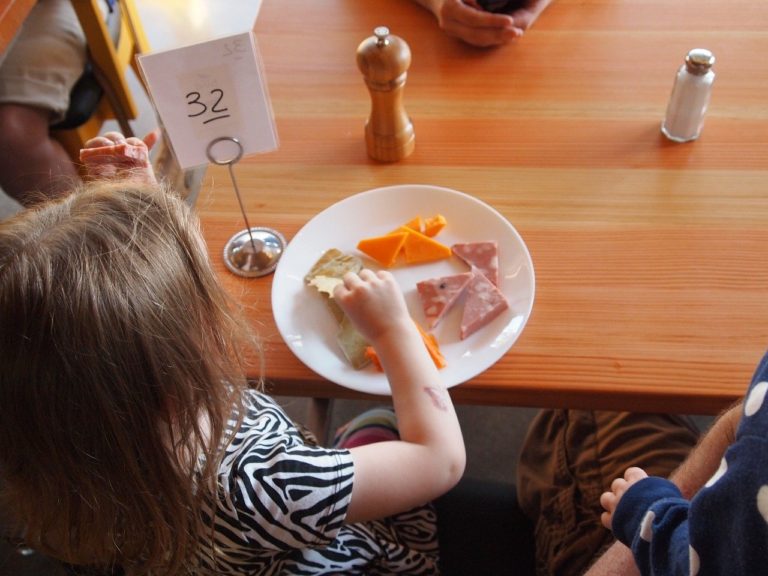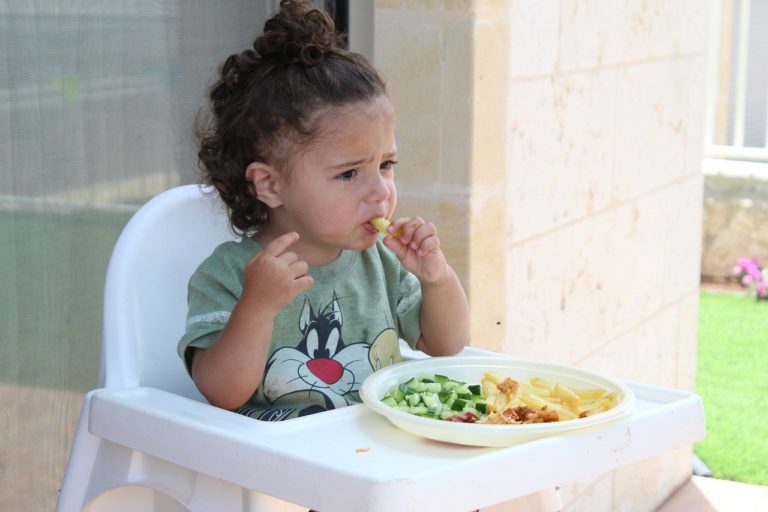There is something about feeding our children that makes even the most well balanced parent turn a little, well… neurotic. We measure ounces when they are babies and count calories when they are toddlers and preschoolers. Yet despite some of our best efforts, a handful (or more) of us end up with children who don’t want to eat anything it seems. This blog is about how to fix a picky eater, and if we are lucky, maybe even how to prevent one.

The Parental Fear
I think one reason meal time becomes such a battle is because there is this fear that if your child doesn’t eat, they are going to starve. Don’t get me wrong, I think we all know logically that isn’t what is going to happen. But we can’t help going there. We have to ask ourselves at what point does picky eating become a problem?
I believe we worry about being a bad parent. They worry that if their children are not eating well, they won’t grow well. All we want is for our children to grow and be healthy. If you have a picky eater, I challenge you this: let it go. You can still be anxious and worry, we won’t pretend that’s going to go away immediately. But I am going to challenge you to try not to let those fears override your mind at the meal table. Follow my other tips on how to overcome picky eating and give changing the meal time dynamic a try, without tears from you or your child.
Re-Experiencing Food
I know it’s really easy to make light of the toddler picky eating phase. I know it’s tempting not to understand where your child is coming from. So I want to challenge you to try to re-experience the foods you are offering your child. Imagine these foods are new to you. How do you feel about them? How do they taste? Look? Feel? Is there perhaps a very valid reason your child isn’t interested in eating the food you are serving? And remember, as adults, we don’t like every single food ever. No one has to like everything. Don’t expect anything different from your child. They get to dislike foods too. We just want to encourage them to try them a few times before they decide they don’t like them.
Taste
Let’s start with the easy one, taste. Think about all the foods that you are serving your child. How do they actually taste. Are they sweet? Sour? Bitter? Bland? Children have more sensitive palates than we do, so be aware of the flavors that are being offered. Too much flavor can be overwhelming for your child. Think honestly about how much many of us enjoy sweets. That can be in the form of candy, but also in the form of fruit. We like sweet tasting foods. So we can’t be upset with our children for enjoying the same.
Texture
For me, even as an adult, texture is HUGE. I cannot do mushy foods. For example, I cannot eat applesauce without gagging. Think about the textures that our food has. It can be slimy, solid, slippery, mushy, crunchy. For children, the texture really matters. Some children will lean towards a certain feel of food. This feel can be both in their hands and in their mouths. Some children won’t eat yogurt because it is messy in their opinions. Know your child, and try to offer variety on their plates.
Sight
Finally, don’t underestimate the way your food looks. If you want your children to eat something, especially if it’s for the first time, think about how it looks. And don’t think like an adult, think like a child. If it’s full of bland colors or is a pile of mush, that might not be enticing to your child. Try to offer fresh, vibrant foods to them. Also, where some children don’t mind if you hide vegetables in their foods, other children may become very upset that their foods are touching. Think about what is going to work well for your child.

Introducing New Foods
Introducing new foods to your child should involve some thought on your part. You want to think about how it will look, how your child might respond, and how you might make it fun. Be sure you are going to have to introduce this new food a few times, maybe even in a few different ways. Again, we are not fighting with our children to get them to try it. We are offering it and letting them experience it first.
Presentation
I know I said this already, but the way our food looks when served to children can matter to a lot of them. Be sure to think about how it looks and smells while you are making it, once it is finished, and then again on your child’s plate. Sometimes you only get one chance to convince your child to try a new food, so you want the first impression of that food to be a positive one.
The Rule of 7 (or 11 or 20 or 100)
The rule of 7 is this: you have to be exposed to something new 7 times before you will act on it. In this case, your child may need to be exposed to a new food 7 times before they will even consider trying it. Now personally, I know that food waste upsets me… a LOT. So be prepared to only serve small portions for the initial exposure. Then you don’t have to get wrapped up in the stress of throwing away perfectly good food. Plus, in my opinion, if your child hasn’t even touched it, there is no compelling reason you can’t save it for leftovers later.
The point is, the first time you serve something, or the first 6 times you serve something, don’t be surprised if your child wants nothing to do with it. Keep it casual, and don’t harp on them to try it. I will say they do have to keep it on their plates for the duration of the meal though, even if they have no intention of trying it.
Know Your Child
For all my years of experience, and all the wisdom I can offer you, at the end of the day, you know your child. Be aware of what they like or don’t like. Know what will work for them and stay consistent. If you know something is going to cause a meltdown, do your best to avoid it. On the flip side, if there are tried and true ways to help your child get excited about a new experience, do them!
Examples can be maybe they can’t handle any of their food touching. Maybe the first time they eat spinach you might have to hide it inside something they already know and love well. Or perhaps it will help to hype up the new food in advance or maybe not comment at all. You know what your child will respond to best.
Make It Fun
Years ago now I worked for a school and we had a Fun with Food Friends program. A quick Google search yielded me nothing useful on that front, so I don’t know if it is a popular program anymore. But the idea was that you read books, had puppets, and made a big to do about not just trying the specific foods (I think there were maybe 6 of them) but also being open to trying new foods in general. We would do the same food for one or two weeks (my memory is a bit foggy now) and would offer that food every day for those two weeks. No pressure to try it, just fun. Plus each food had a corresponding puppet with a name, like Daikon Radish and Gouda Cheese. This got the children excited in a different way.
While the Food Friends program might not be around anymore, the sentiment behind it is still there for me. Make trying new foods fun. This includes playing games, letting your children explore them and make a mess. Most specifically though, try to avoid making it a fight.
Modeling
Finally, if you are going to ask your child to eat something, you better be sure you’re eating it too. You need to model a willingness to try new foods. You also have to model a willingness to try foods you’ve tried before and think you don’t like. You are the person your child looks up to the most. So be sure your plate is reflective of a well balanced meal as well.
Enjoying Meals
Now that we have some tips and tricks to make introducing new foods a little more appealing, let’s get back to what’s most important, enjoying meals together. The key to healthy life choices around food has very little to do with what you eat right now. Don’t get me wrong, nutrition is important. But we want to instill a positive experience with food for our children.
No Tears
My first rule is no tears. If anyone is crying, or about to cry (including you!) it’s time to reset. We aren’t crying at the table. Nothing is so worth trying that it gets us that upset. Now this is different from general tantrums, such as being upset they have to sit in their chair or they can’t have dessert right now. I’m talking about the tears that stem from parents pushing too hard to be open to new foods.
Low Preassure
Speaking of pushing, let’s let off some of the pressure we’ve been building for our children around meal times. Yes, continue to offer new foods. Yes, encourage your child to try them. Yes, even offer foods that your child says they don’t like. But let it go if it isn’t happening tonight. Remember, meal times are just one more time that your child gets little to no say in what they get to do. Let it be just a light, pleasant experience.
Time
I always caution new parents against setting unrealistic time expectations for young children to be at the dinner table. Do not expect your toddler to eat with you for an hour. Do not expect your preschooler to sit through a three course meal. Have everyone sit down at the same time so everyone has a chance to eat. This is especially true for moms, who are often serving their children, and by the time they are finally able to sit down to a meal themselves, the kids are done. Then we ask the kids to stay at the table so we can eat and then are somehow surprised when our kids start demonstrating behaviors we are not okay with.
Meal times should last 15-30 minutes. Anything beyond that means you have offered something that is extra positively received. Live up those long meals, but don’t try to push day to day eating to last a super long time.

Overcoming Picky Eating
Maybe you are over here like, this is all cute, but it’s too late. My child is already a picky eater and mealtime is the worst. That’s okay! This section is for you. Start by reading and starting to implement the things above. Just because you might be stuck in a rut doesn’t mean you have to stay that way forever.
Trust That They Won't Starve
First, I need you to trust your child not to starve themselves to death. This is hard, especially in a society where “failure to thrive” gets thrown around worse than an ADHD diagnosis. If you create the container though, your child will fill it. But you have to create the container.
One Meal
Start with just one meal. I always say if my child eats at least one meal every day, they are getting their nutrition. That means that if they ate a huge breakfast, don’t ask them to also eat a huge lunch. There is a lot of research questioning if the 3 meals a day approach is really the right approach for humans anyway. So do not cater every meal to what you think they will like. If you are worried about them really not eating, start with making sure at least one meal a day is a meal they will eat. The rest of the meals, offer what you would normally be eating. No more chicken nuggets or mac-n-cheese for every meal. It’s time to offer real food, and the more you expose your child to it, the better.
At that one meal, make sure to focus on the newer or disliked foods first. If you are having fruit with your meal, maybe keep it put away for 15 or so minutes at the beginning of the meal. This way they can sit with other food for a little while before chowing down on the stuff you know they will eat (most, albeit not all, children will eat fruit).
One Food
If the approach of ensuring one meal a day doesn’t sit well with you, you can simplify it down even further to just one food per day. This means at each meal you offer one new food, along with the rest of the food you know your child will eat. There is still no forced trying of anything, although it certainly should be encouraged. Not on another plate, either. This food should be on the same plate as the rest of their food. To start, maybe this leads to major melt downs, even a refusal to eat anything else on their plate. Do not remove the food. It isn’t going to destroy them to have the food sitting on their plate. They can still eat the rest of their meal (or not) and they don’t have to eat the new food. But it needs to be where they can see it.
The key here is that you are offering the food. Often times this means that one food will sit there on their plate the entire meal. Sometimes this means that food is thrown away, or the rest of the plate is abandoned as well. This is okay. Again, you know your child isn’t starving. You are trying to expose them to the idea of new foods. When people comment on how surprising it is when a child eats something like sushi or salads, I am rarely surprised, as it often means the parent offers it to them frequently.
No Snacks
I’m not trying to take away snack time completely, or encourage you to ignore your child’s hunger cues. But often, the snack situation gets out of control. If your child refuses to eat meals, they should not then get to have a whole bunch of snacks later on because they are hungry. Why would they try new foods or eat meals when they can get away with delicious treats later. And for the most part snacks tend to be junky. Even “healthy” snacks are often fruit (sweet) or vegetables with some sort of dip such as peanut butter or ranch.
No more. If you are truly committed to fixing this picky eating situation, then you have to stop offering alternatives. If your child doesn’t eat a meal, you can always put that meal away and if they are hungry later, offer it to them again. They will either eat it because they are hungry, or refuse again because they aren’t all that hungry after all.
My one caveat to the no snack rule is that I will offer children a nutritional snack around 3:30 or 4:00pm each day that is different from meals. This is to help them get from the lunch hour to the dinner hour.
Family Style Meals
Family style meals is a term used in the Early Childhood field for eating as a family. Now this might sound incredibly obvious, but it is not a practice that many families partake in. The idea is that everyone sits down to eat together. You are creating an intentional setting for the whole family to come together and share a meal. This should also mean no TV, no video games, and no phones, including for parents.
The conversation during these meals should be pleasant, and enjoyable. It’s a time for the family to catch up together, or talk about something they did for the day. When my children were very young, I had a list of questions, one for each day of the week, that I would ask them, such as what their favorite part of the day was, or what was something they learned, or what was something the failed at. Now that my children are older, they lead the conversation pretty well on their own.
There are a few participation rules for family style meals as well. One is that children serve themselves. This helps teach them portion sizes, supports their independence, and empowers them. They should still take a little of everything offered. But if they know they don’t like mushrooms, instead of having a huge heaping cup on their plate, that was provided by an adult, they can get just a little, tiny scoop. This also can open conversations about listening to your body, and gives you more room to hold them accountable for eating what they have already taken before getting seconds.
Another rule that I have is that they have to stay at the table until everyone has had a chance to eat. Too often I see moms running around getting food, serving people, cleaning up, and so on. Then, by the time mom gets to sit down, the children are done eating. For family meals, everyone should sit together and eat together, even if that means your child has to be at the table for an extra 5 minutes. Now I’m not saying make them sit down for a full 45 minutes, but I am saying it’s acceptable to have a minimum amount of time that your children are expected to be at the table so that everyone in the home has the opportunity to eat.
Finally, part of family meals is participating in the meal itself. Sometimes this means helping cook. Other times it’s as simple as setting the table and clearing their own plates. I have children as young as 18 months clear their plates from the table, scrape them in the trash, and stack them in a designated location. So do not doubt your young child’s ability to manage themselves. At my house, my youngest is 3 right now. I am responsible for opening the dishwasher drawer and pulling the racks out. Both of my children clear their plates, scrape them, rinse them in the sink, and put them in the dishwasher. Hopefully this will build a habit for those teenage years.
Offer Water
I want to urge you to avoid falling into what I call “the beverage trap”. Some children will fill up on milk (heck, I’m an adult and I can fill up on milk!). Their stomachs are only so big, so if your child tends to drink milk and nothing else, limit them to one small glass per meal.
I also encourage families to strike juice from their diets completely. Juice is mostly sugar and offers little to no nutritional value. It is also terrible for your teeth and even easier to fill up on than milk. The only drinks that should be on the table at meal time are 1 single glass of milk (and even then , I would argue that’s optional), and water.
Avoid Bribery
My very last point here is to avoid bribery or aggressiveness at all costs. We are not pleading with our children to eat. There should be neither reward nor punishment for a ‘clean plate’. We want to teach our children that food is a positive experience, but that they should listen to the needs of their bodies. Do not try to convince them to eat by offering dessert afterwards or
threatening them with punishment. We need to take the pressure off in all directions. Now if you are not comfortable offering your child dessert when they refused to eat, that’s fine. Simply do not offer them dessert. Sugar is a highly addictive substance anyway, so the less it’s in your home, the better for everyone.
Fun Books
Still Struggling?
If you are still struggling with eating in your house and would like a second opinion, I can work with your family to support eating at home. My process involves a few meetings, some observations, a family conversation, and a plan. You can learn more about it under my Behavioral Services.



















Pingback: Fun Mementos for Growing Families – Freedom Inside the Box
Pingback: Feeding Your Baby in the First Year – Freedom Inside the Box